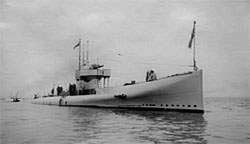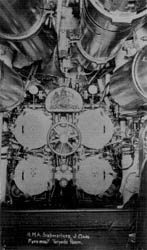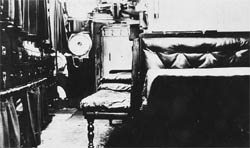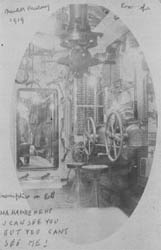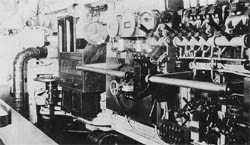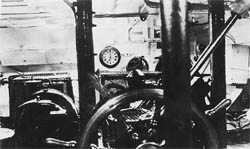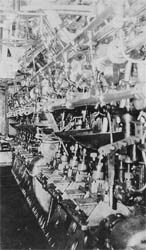|
||||||||||||||||
|
|
||||||||||||||||
|
|
The British J Class Submarines were built under an emergency war program caused by an erroneous report that the German Navy had U-Boats at sea or under construction capable of attaining speeds of 18-20 knots. At that time the British Navy was experimenting with steam driven turbine powered submarines which were later to become the K Class. As these vessels were only experimental they were forced to design a fast submarine using existing technology. The resulting J Class submarines were over 100 feet longer than their predecessor the E Class.
In January 1915, 8 J Class submarines were ordered however only 7 were built. Unique to British submarines the J class subs were designed with triple screws making them the fastest of their time with a surface speed of 19 knots.
The unit was to suffer very few casualties during the war however one of the most tragic incidences of the war occurred at 4.30 pm on the 15th October 1918 when the Royal Navy Decoy ship Cymric mistakenly attacked and sunk the J6 with the loss of 16 men. A court of inquiry verdict could not lay the blame on anyone 'as it was all part of the game!' (21).
At the completion of the war Britain offered the six remaining submarines and 6 destroyers (renamed as H.M.A.S Platypus (depot Ship), Sydney (light cruiser), Brisbane and Karumba) as a gift to Australia on the 13th February 1919, they were officially transferred to the RAN on 25th March 1919 (17). The total value of this gift was approximately 1.5 million pounds. This small fleet departed from Portsmouth on 9/4/1919 and arrived in Sydney on 15/7/1919 (18). Note Australia's first submarines were the AE 1(80) and the AE 2(81), these two were of the E Class. The AE 1and the AE 2 were sisters to the RN E Class. They possessed torpedo tubes at the bow, stern and on each beam. A maximum of eight torpedoes were carried. Both submarines were lost in WWI. AE 1 without trace near Cape Gazelle, 14 September 1914 and AE 2 in the sea of Marmora, Turkey, 30 April 1915 (19).
Upon arrival in Australia, all the submarines were in poor condition and had to undergo extensive refits. This was due to the fact that these boats were not refitted in England before being turned over to the Commonwealth and sailing for Australia (13). They were immediately refitted at the Garden and Cockatoo Island Commonwealth Naval Dockyards at a total cost of 407 000 pounds and the completion dates were as follows:
The decision to scrap the submarines J1-5 was taken on the 19/11/1923 following a cut in the defense budget by some 500,000 pounds. The decision to scrap the J7 came on the 16/l/1924. The J7 though in fairly good condition after just being refitted was described as the last survivor of an obsolete class. She could not be used for training unless a crew was obtained from England. In any case it was decided that future crews should be trained on modern submarines. In January, 1924 the Melbourne Salvage Company (also referred to as Melbourne Salvage Syndicate and Melbourne Salvage Pty. Ltd.) of 60 Queen Street, Melbourne purchased the J1,J2,J4 and J5 for 10,500 pounds. The purchasers were under a bond of 1,000 pounds to the Defence Department as guarantee of the final destruction of the submarines. The contract also included the sinking in deep water or breaking up or otherwise disposing of the submarines to the satisfaction of the government contract board. The Melbourne Salvage Company also purchased the Cerberus which it later sold to the municipal authorities at Sandringham. In 1926 the Cerberus was towed to her final resting place at Half Moon-Bay where she now serves as a breakwater (10). The J4 prior to being scuttled in Bass Strait had spent two years on the harbor floor after sinking off Nelson Pier, Williamstown, after a supposed severe storm on the 10 July 1924. The J4 had already been purchased by the Melbourne Salvage Company and had only been delivered that day to the Williamstown dockyard by government officials. The Melbourne Salvage Company entered into an agreement with Williamstown Dockyard (Prime Ministers Department) to dismantle the J4. Several attempts were made to raise the submarine but with mixed success. The J4 was partially raised on the 26 November 1926 only to sink again a short time after. On the 6th December 1926 the J4 was successfully raised.
The Melbourne Salvage Company contracted McBain and Morwick to sink the hulls of J1, 2 and 5 outside the three mile radius of Port Phillip Heads. Prior to scuttling target practice was made of the J5, eight bombs were dropped from a height of 3000 feet by five planes and two sea planes which circled overhead. The nearest bomb being 150 feet short of target. After the unsuccessful bombing a boarding party opened the seacocks and J5 went to the bottom (12). A Mr. Hill of 77 Chapman Street, North Melbourne purchased the hull of the J3 and some fittings off the Countess of Hopetoun (11). In January 1926 the hull of the J3 was sunk off the northeastern tip of Swan Island where it had been moored since 1922. The hull was to be used as a pier. The two bronze propellers (the battery powered ones opposed to the main diesel driven propeller were removed and are on display opposite the Queenscliffe Maritime Center (4). Folk history relating to the Swan Island site indicates that the vessel was run onto the shore of Swan Island so that the diesel powered generators could be used to provide an auxiliary power supply to the military establishment on the island (12). The J3 lies upright on the seabed in 6 meters of water with the upper deck and superstructure protruding above the water at all times. The bow of the submarine faces eastnortheast and is approximately 100 meters from the shore of Swan Island. Strong tidal conditions exist on the site at 90 degrees to the long axis of the vessel. Diving is safely carried out on the lee side of the vessel during the running tide which can run upto 2 knots at full tide. Visibility on the site ranges between 0.5 - 4.0 meters. Note the site lies within the Swan Island Prohibited Area (4). Note the site is marked but not named on the 1981 version of AUS 158 (4).
Written permission from the M.A.A.V. is required for the publication of any material. Any use of this material should credit the Maritime Archaeology Association Of Victoria.
Last modified: March, 2011 |
|||||||||||||||
